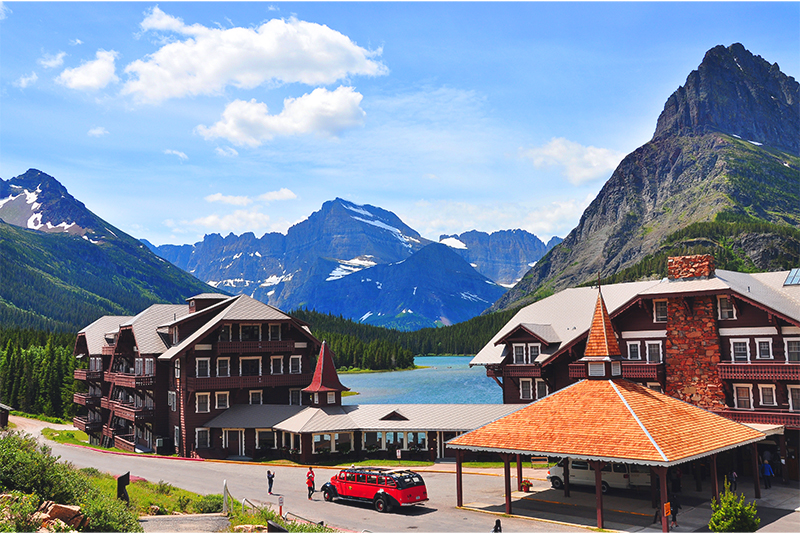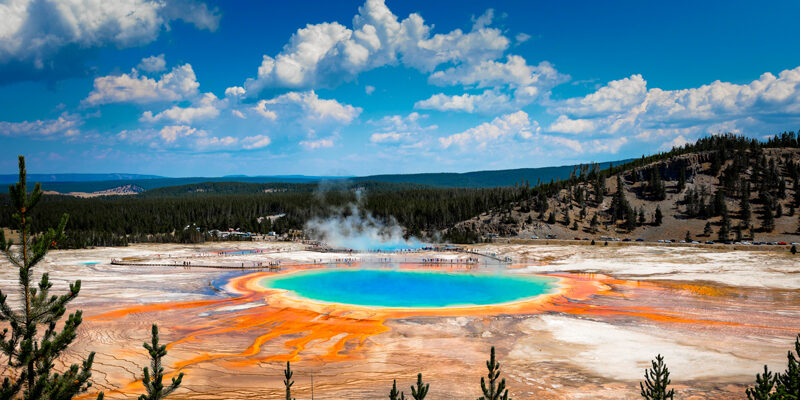When people think of UNESCO World Heritage Sites, it’s often associated with areas in Europe, Asia and Africa. It may come as a surprise to many that there are several locations within the United States that are listed as important to the development of modern culture and mankind.
World Heritage Sites within the United States
The United States boasts a diverse array of UNESCO World Heritage Sites, each offering a unique glimpse into the nation’s cultural and natural heritage. As of January 2025, there are 26 such sites across the country. Additionally, the U.S. maintains a Tentative List of sites under consideration for future nomination. Here, we explore these remarkable locations and provide an overview of the sites on the Tentative List.
1. Mesa Verde National Park (Colorado) Designated in 1978, Mesa Verde preserves the ancient cliff dwellings of the Ancestral Pueblo people. Visitors can explore over 600 cliff dwellings, including the famous Cliff Palace, offering insights into a civilization that thrived from AD 600 to 1300.
2. Yellowstone National Park (Wyoming, Montana, Idaho) Also inscribed in 1978, Yellowstone is renowned for its geothermal features, including the iconic Old Faithful geyser, and its diverse ecosystems, home to species like grizzly bears, wolves, and herds of bison and elk.
3. Grand Canyon National Park (Arizona) Recognized in 1979, the Grand Canyon is a geological marvel carved by the Colorado River over millions of years. Its immense size and intricate landscapes offer breathtaking vistas and a rich geological record.
4. Everglades National Park (Florida) Inscribed in 1979, the Everglades is a unique wetland ecosystem that supports a variety of wildlife, including endangered species like the American crocodile and the Florida panther.
5. Independence Hall (Pennsylvania) Designated in 1979, Independence Hall is the birthplace of the United States, where the Declaration of Independence and the Constitution were debated and adopted.
6. Redwood National and State Parks (California) Recognized in 1980, these parks protect some of the tallest and oldest trees on Earth, the majestic coastal redwoods, as well as diverse ecosystems ranging from prairies to oak woodlands.
7. Mammoth Cave National Park (Kentucky) Inscribed in 1981, Mammoth Cave is the world’s longest known cave system, with more than 400 miles of explored passageways, offering a subterranean landscape of limestone labyrinths.
8. Olympic National Park (Washington) Designated in 1981, Olympic National Park encompasses diverse ecosystems, from rugged coastlines and temperate rainforests to alpine peaks, supporting a wide range of plant and animal species.
9. Cahokia Mounds State Historic Site (Illinois) Recognized in 1982, Cahokia Mounds is the largest pre-Columbian settlement north of Mexico, featuring monumental earthworks that reflect a complex and sophisticated society.
10. Great Smoky Mountains National Park (Tennessee, North Carolina) Inscribed in 1983, the Great Smoky Mountains National Park is celebrated for its biodiversity, ancient mountains, and remnants of Southern Appalachian mountain culture.
11. La Fortaleza and San Juan National Historic Site (Puerto Rico) Designated in 1983, these fortifications represent European military architecture adapted to the Caribbean context, reflecting the island’s strategic importance.
12. Statue of Liberty (New York) Recognized in 1984, the Statue of Liberty is a universal symbol of freedom and democracy, welcoming immigrants arriving by sea to the United States.
13. Yosemite National Park (California) Inscribed in 1984, Yosemite is famed for its stunning granite cliffs, waterfalls, giant sequoia groves, and rich biodiversity, attracting millions of visitors annually.
14. Chaco Culture (New Mexico) Designated in 1987, Chaco Culture National Historical Park preserves the monumental architecture and complex society of the Chacoan people, who inhabited the area from AD 900 to 1150.
15. Monticello and the University of Virginia in Charlottesville (Virginia) Recognized in 1987, these sites reflect the architectural and educational vision of Thomas Jefferson, embodying Enlightenment ideals.
16. Hawaii Volcanoes National Park (Hawaii) Inscribed in 1987, the park encompasses two of the world’s most active volcanoes, Mauna Loa and Kilauea, offering insights into volcanic processes and Hawaiian cultural traditions.
17. Taos Pueblo (New Mexico) Designated in 1992, Taos Pueblo is an ancient Native American community continuously inhabited for over 1,000 years, showcasing traditional adobe architecture.
18. Carlsbad Caverns National Park (New Mexico) Recognized in 1995, Carlsbad Caverns features more than 119 caves formed by sulfuric acid dissolution, including the spectacular Big Room, a natural limestone chamber almost 4,000 feet long.
19. Waterton-Glacier International Peace Park (Montana, USA / Alberta, Canada) Inscribed in 1995, this transboundary park symbolizes peace and cooperation between the U.S. and Canada, encompassing stunning mountain scenery and diverse habitats.
20. Papahānaumokuākea (Hawaii) Designated in 2010, Papahānaumokuākea is a vast marine conservation area of deep cultural significance to Native Hawaiians, encompassing coral reefs, islands, and atolls.
21. Monumental Earthworks of Poverty Point (Louisiana) Recognized in 2014, Poverty Point is an archaeological site dating from 1700 to 1100 BC, featuring massive earthworks that reflect a complex, prehistoric indigenous society.
22. San Antonio Missions (Texas) Inscribed in 2015, the San Antonio Missions are a group of five frontier mission complexes that illustrate the Spanish Crown’s efforts to colonize, evangelize, and defend the northern frontier of New Spain.
23. The 20th-Century Architecture of Frank Lloyd Wright (Various States) Designated in 2019, this site comprises eight buildings across the U.S. designed by architect Frank Lloyd Wright, showcasing his influence on modern architecture.
24. Hopewell Ceremonial Earthworks (Ohio)
Inscribed in 2023, the Hopewell Ceremonial Earthworks encompass eight monumental earthworks constructed by the Hopewell culture between 1 and 400 AD. These sites, located along tributaries of the Ohio River, showcase the architectural and astronomical sophistication of pre-Columbian Native American societies.
25. Moravian Church Settlements (Various States)
Added to the World Heritage List in 2024, the Moravian Church Settlements include historic communities established by the Moravian Church in the 18th century. These settlements are notable for their unique town planning, architecture, and cultural landscapes that reflect the religious and social ideals of the Moravian community.
26. Kluane / Wrangell-St. Elias / Glacier Bay / Tatshenshini-Alsek (Alaska, USA / British Columbia and Yukon, Canada)
This transboundary World Heritage Site, designated in 1979 and extended in subsequent years, encompasses vast wilderness areas characterized by towering mountain ranges, glaciers, and diverse ecosystems. It is one of the largest protected areas in the world, offering habitat to species such as grizzly bears, caribou, and Dall sheep.
U.S. Tentative List for UNESCO World Heritage Sites

The United States maintains a Tentative List of properties that it considers for future nomination to the World Heritage List. As of January 2025, the Tentative List includes the following sites:
- Big Bend National Park (Texas)A vast expanse along the Rio Grande, Big Bend is renowned for its rich biodiversity, dramatic canyons, and geological features.
- Brooklyn Bridge (New York)An iconic feat of 19th-century engineering, the Brooklyn Bridge connects Manhattan and Brooklyn over the East River.
- California Current Conservation Complex (California)This marine area is significant for its rich marine biodiversity and productive ecosystems influenced by the California Current.
- Central Park (New York)A masterpiece of landscape architecture, Central Park serves as a green oasis amidst the urban environment of Manhattan.
- Civil Rights Movement Sites (Various States)These sites are pivotal in the history of the Civil Rights Movement, marking significant events and figures in the struggle for racial equality.
- Dayton Aviation Sites (Ohio)Associated with the Wright brothers, these sites are integral to the history of aviation and the development of powered flight.
- Early Chicago Skyscrapers (Illinois)These pioneering structures in Chicago represent the birth of the skyscraper and advancements in architectural design and technology.
- Ellis Island (New York/New Jersey)The principal gateway for millions of immigrants to the United States, Ellis Island is emblematic of the American immigrant experience.
- Marianas Trench Marine National Monument (Northern Mariana Islands)Encompassing the deepest part of the world’s oceans, this monument is significant for its unique geological and biological features.
- Marine Protected Areas of American Samoa (American Samoa)These areas safeguard diverse marine ecosystems, including coral reefs and species endemic to the region.
- Mount Vernon (Virginia)The plantation home of George Washington, Mount Vernon reflects the life and legacy of the first U.S. President.
- Okefenokee National Wildlife Refuge (Georgia)A vast wetland preserve, the Okefenokee is notable for its biodiversity and unique swamp ecosystem.
- Pacific Remote Islands Marine National Monument (U.S. Minor Outlying Islands)This monument protects a large area of the central Pacific Ocean, preserving coral reefs, marine species, and submerged lands.
- Petrified Forest National Park (Arizona)Known for its extensive deposits of petrified wood, the park offers insights into the Late Triassic period’s ecosystem.
- Serpent Mound (Ohio)An ancient effigy mound representing a snake, Serpent Mound is significant for its prehistoric indigenous cultural origins.
- Thomas Jefferson Buildings (Virginia)Including Monticello and the University of Virginia, these buildings reflect Thomas Jefferson’s architectural vision and Enlightenment ideals.
- White Sands National Park (New Mexico)Home to the world’s largest gypsum dune field, White Sands presents a unique desert landscape and ecosystem.
These sites reflect the rich cultural and natural heritage of the United States and are under consideration for future nomination to the UNESCO World Heritage List


































